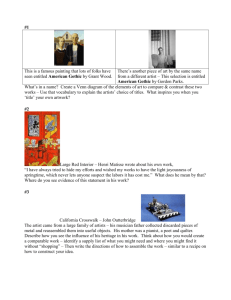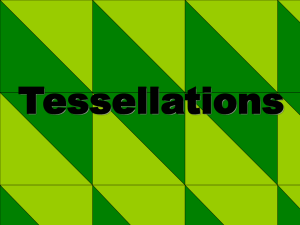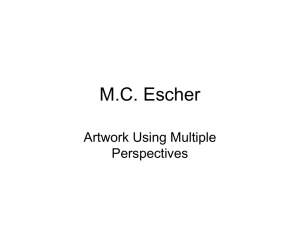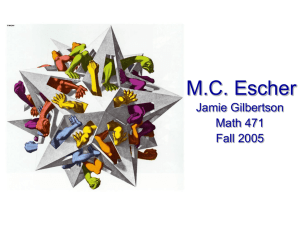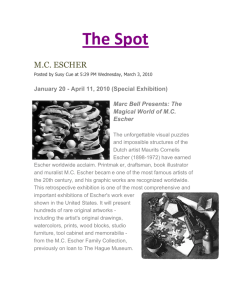MATH2.Task1
advertisement
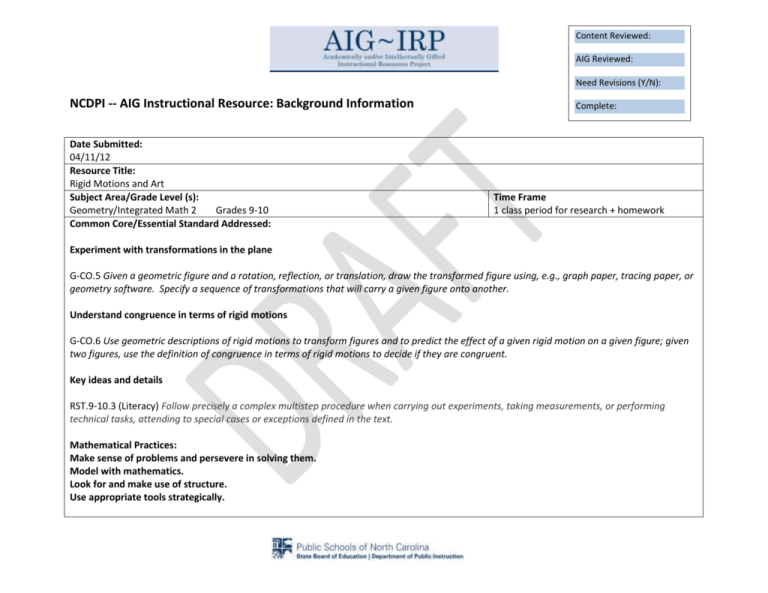
Content Reviewed: AIG Reviewed: Need Revisions (Y/N): NCDPI -- AIG Instructional Resource: Background Information Date Submitted: 04/11/12 Resource Title: Rigid Motions and Art Subject Area/Grade Level (s): Geometry/Integrated Math 2 Grades 9-10 Common Core/Essential Standard Addressed: Complete: Time Frame 1 class period for research + homework Experiment with transformations in the plane G-CO.5 Given a geometric figure and a rotation, reflection, or translation, draw the transformed figure using, e.g., graph paper, tracing paper, or geometry software. Specify a sequence of transformations that will carry a given figure onto another. Understand congruence in terms of rigid motions G-CO.6 Use geometric descriptions of rigid motions to transform figures and to predict the effect of a given rigid motion on a given figure; given two figures, use the definition of congruence in terms of rigid motions to decide if they are congruent. Key ideas and details RST.9-10.3 (Literacy) Follow precisely a complex multistep procedure when carrying out experiments, taking measurements, or performing technical tasks, attending to special cases or exceptions defined in the text. Mathematical Practices: Make sense of problems and persevere in solving them. Model with mathematics. Look for and make use of structure. Use appropriate tools strategically. Additional Standards Addressed: (integration across topics, within or across disciplines) Visual Art – I.CX.1.3 Classify art by artist, movement, and style. I.V.1.4 Analyze images through the process of deconstruction (the components of the image and its meaning). Brief Description of Lesson/Task/Activity: (include how this lesson/task/activity fits with a larger context) Students will investigate the artwork of M.C. Escher, his style of work, and the process which can be used to tessellate figures. Students should use the internet or resource books to research Escher’s artwork to learn the method(s) he used to design and draw his tessellations. A good article can be found at the following website: http://www.math.nus.edu.sg/aslaksen/gem-projects/maa/Understanding_Escher.pdf. Students will create their own complex figure (from a regular polygon) to tessellate using the methods found in research and will then create their own piece of art. This task is meant to challenge students to design a complex figure, preferably a figure that is designed to mimic an object (i.e. animal). Students should refer to the article link above in order to understand the expectation for this task (pages 6-17). Students can also refer to other works by M. C. Escher for examples. Students will describe their creative process using appropriate vocabulary and clarifying details. Type of Differentiation for AIGs (include all that apply) X Enrichment X Extension Acceleration Adaptations for AIGs X Content Process X Product Explanation of How Resource is Appropriate for AIGs This task is appropriate for AIG learners because it asks them to use their knowledge of rigid motions and geometric figures to create a piece of artwork. This activity is appropriate for students who have mastered the basic standard. They will be investigating congruence through Eschertype tessellations which may involve translation, rotation, reflection, and/or glide reflection. By completing this task, students will use various methods of inquiry to relate the mathematical ideas of rigid motions to art. Students are required to be creative and to use discovery skills in order to determine the best method for creating their drawing. One of the important requirements of this task is that students are required to research, read, and process much of the information about Escher’s methods on their own. Students will research Escher’s artwork and the processes he used in his drawings to change a regular polygon into a complex non-polygon suitable for tessellation. Students experiment with their design to apply the appropriate type of rigid transformation(s) to their non-polygon in order to create a minimum 8 ½ x 11 piece of artwork. Needed Resources/Materials Students will need to have access to the internet for research or access to books relating to M.C. Escher’s artwork. It would also be helpful to have posters or prints of Escher’s artwork for discussion as a class if this activity is to be used for whole class enrichment and extension. This task is recommended for students who have already mastered the standard. Paper, colored pencils, markers, crayons, and/or chalks would be helpful as well. Sources (all sources must be cited) Foo Huimin, V., Xu Hanni, L., Zhu Ming-Ren, W., (n.d.). Understanding Escher. Retrieved from http://www.math.nus.edu.sg/aslaksen/gemprojects/maa/Understanding_Escher.pdf TEACHER NOTES Students must have an understanding of translation, reflection, rotation, and glide reflection as well as congruence. NCDPI AIG Curriculum Resource Outline Describe processes, steps, and materials needed at each stage of the lesson/activity. STAGE ONE: Engage X Hook X Prior knowledge Instructional input Modeling Description: Introduce students to Escher’s artwork using posters, images from the internet or texts, and resource books. Ask students to describe possible rigid motions illustrated in his works. Students should be able to justify their descriptions using mathematical vocabulary and reasoning. This can be done in a whole class/group setting with all AIG learners to generate discussion or as a written assignment or pretest. Provide students with resources related to Escher’s work and pose the following questions (to be answered in discussion or in writing): What inspired Escher’s work? What processes did Escher use to create his images? What problems did he come up against as he created them? STAGE TWO: ELABORATE X X Guided and independent practice Guiding questions Description: The teacher can introduce students to this task by having students take a basic polygon, such as a parallelogram, and tessellate it on an index card as a simple example. As students research, they should discover a method for creating a complex figure from a regular polygon that can be reproduced using reflection, rotation, translation, or glide reflection. Students should be able to answer the following questions: How can geometric transformations be used to create tessellations? Which transformations can be used to tessellate or create repeating patterns? What steps can be taken to transform a regular polygon into a non-regular polygon suitable for tessellation? How can you be certain your non-polygon can be used in a repetitive pattern? (Students should be required to make multiple changes in the regular polygon , i.e. changes on all sides of the polygon, in order to make the resulting non-polygon more complex and challenging. The goal of this task is for students to create a figure similar to the types of figures in Escher’s artwork. See Article documented above, pages 10-17). How does Escher’s work display a sequence of transformations? Why do some shapes tessellate and others do not? Make a conjecture about the shapes suitable for tessellation and support your conjecture with examples/drawings/explanations. STAGE THREE: EVALUATE X Assessment Description: Students should create an 8 ½ x 11 (minimum) piece of artwork that clearly demonstrates the use of rigid motions. Students should be required to incorporate pattern and/or color and/or details into their art. Students should have a clear description of the process they used to create their drawing. Teachers can use a rubric to assess their writing and product according to the following criteria. The writing assignment describes the creative process and includes illustrations and the mathematical process used to create the drawing. Students should support their choice of rigid motion used to achieve the desired results and should use mathematical vocabulary and reasoning in their descriptions. The tessellation created uses a complex non-polygon that was derived from a regular polygon. The artwork is at minimum 8 ½ x 11 and includes the use of pattern and/or color and/or details. TEACHER NOTES:
